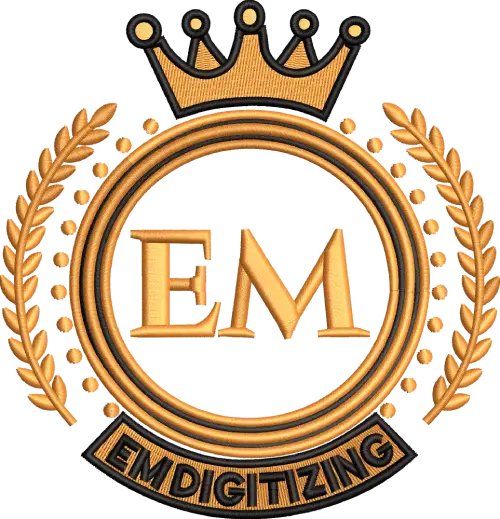Cuando se trata de que tela usar para bordar, No es sólo una cuestión de preferencia, es la diferencia entre un acabado impecable y un desastre frustrante.. Si alguna vez te ha salido un diseño torcido o arrugado, Es probable que la tela fuera parte del problema.. Asi que, ¿Cómo tomas la decisión correcta??

Repasemos siete telas destacadas que pueden realzar el bordado a máquina., desde conceptos básicos para principiantes hasta materiales avanzados para detalles decorativos.
Qué tela usar para bordado | Top tela selecciones?
Las mejores telas para bordar a máquina Nuestra elección

Elegir el tejido adecuado es la base de un éxito bordado a maquina proyecto.
Algunas telas son más estables., más fácil de aro, y dar mejor calidad de puntada que otros.
Here are our top fabric picks that consistently deliver excellent results for machine embroidery:
- Algodón
- Lino
- Poliéster
- Mezclilla
- Sintió
- Lienzo
- Seda
1. Algodón: Your Embroidery Best Friend
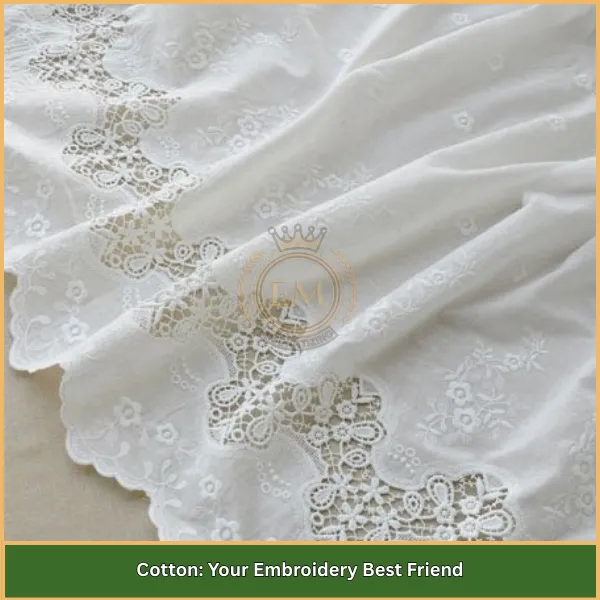
It is one of the most commonly used fabrics in embroidery, especialmente para principiantes. It’s a natural fiber known for its smooth texture, peso medio, and tight weave. These qualities make it extremely easy to hoop and stabilize, helping you achieve clean and consistent stitching.
Cotton handles both light and moderately dense diseños with ease and works well with most stabilizers, como desgarrado o recortado. Pre-washing cotton is essential to prevent future shrinkage, especially if you’re making wearable items.
The fabric comes in a variety of colors, huellas dactilares, and thread counts, making it versatile for home décor, vestir, y proyectos de acolchado.
Price ranges from $5 a $12 per yard, depending on quality and brand.
Beneficios:
- Easy to hoop and prep
- Great stitch clarity
- Amplia gama de gramajes y colores.
Desventajas:
- Se encoge si no se lava previamente
- Se arruga fácilmente
Muchos profesionales lo consideran ¿Cuál es la mejor tela para bordar? al empezar.
2. Lienzo: Para proyectos que necesitan estructura
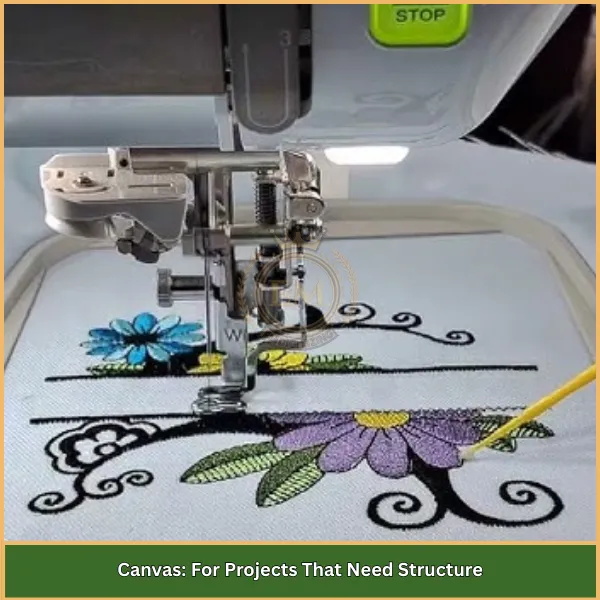
Es un tejido de algodón resistente que es ideal para atrevidos, bordado estructurado.
Con su grueso, textura duradera, El lienzo es la mejor opción para artículos como bolsos de mano., tapices de pared, pancartas, y fundas de asiento.
La rigidez del lienzo lo hace menos adecuado para patrones delicados o intrincados., pero sobresale en el manejo de alta densidad de puntadas.
Porque colocar lienzos en bastidores puede ser difícil, muchas bordadoras lo hacen flotar sobre el estabilizador.
Funciona bien con un estabilizador de corte firme y ofrece cambios mínimos durante la costura.. La textura del lienzo aporta a tus proyectos un acabado profesional y resistente.. espera pagar $6 a $15 per yard, basado en peso y mezcla.
Beneficios:
- Sostiene diseños grandes sin distorsión
- Doesn’;t cambiar una vez estabilizado
Desventajas:
- Requiere agujas fuertes
- Puede ser demasiado grueso para diseños delicados.
If you’;volver a abordar proyectos sólidos, este es posiblemente el la mejor tela para bordar para resultados duraderos.
3. Sintió: Fácil, Asequible, y apto para principiantes
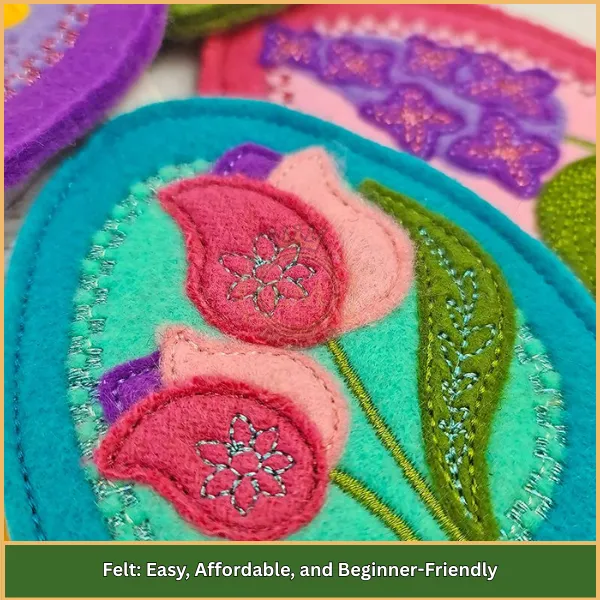
Es un tejido no tejido elaborado a partir de lana natural o fibras sintéticas., por lo que es una opción fantástica para nuevos bordadores o artesanos..
es suave, denso, y no se deshilacha, eliminando la necesidad de acabado de bordes.
El fieltro es excelente para proyectos pequeños como parches., aplique, llaveros, insignias, y adornos navideños.
Admite diseños simples con densidad de puntada ligera.. porque le falta tejido, es extremadamente fácil hacer aro, and it typically doesn’t require backing unless you’;re usándolo para un patrón más denso.
Las láminas de fieltro también están disponibles en varios espesores y colores.. Es extremadamente asequible, normalmente con un precio entre $3 a $8 per yard, o incluso menos para piezas artesanales más pequeñas.
Beneficios:
- Suave y estable
- Se requiere preparación mínima
- No necesita acabado de bordes
Desventajas:
- No admite diseños pesados o densos
- Puede estirarse ligeramente bajo presión.
Esto lo hace ideal para aquellos que se preguntan que tela se usa para bordar al mantener las cosas simples.
4. Seda: Lujoso pero exigente
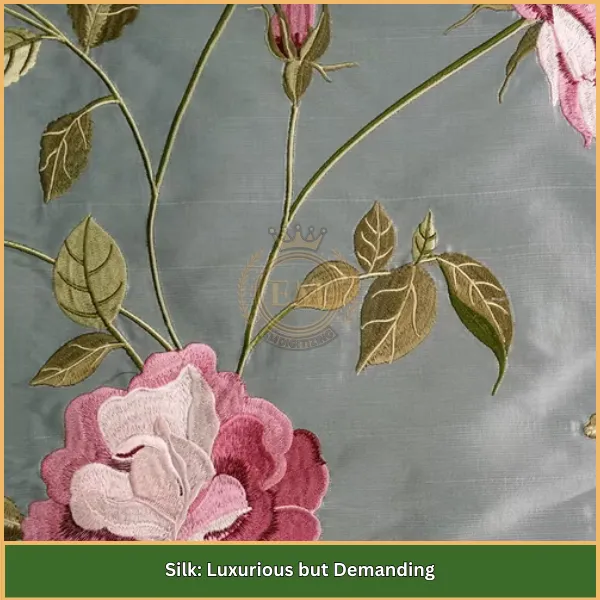
es un peso ligero, liso, y tela lujosa, amado por su brillo natural y acabado elegante.
Se utiliza con mayor frecuencia en bordados decorativos o de alta gama, como piezas nupciales., obra de arte enmarcada, o regalos de herencia.
Sin embargo, La seda es delicada y puede dañarse fácilmente con un aro apretado o una alta densidad de puntadas..
En lugar de colocar seda directamente, many embroiderers float it over stabilizer using temporary adhesive spray or tape.
Pair it with a wash-away or no-show mesh stabilizer and always use fine needles to avoid tearing.
Silk requires slow machine speeds and test stitching. The price of silk ranges from $15 a $40 per yard, depending on its type and quality.
Beneficios:
- Elegant finish with natural sheen
- Great for delicate decorative stitching
Desventajas:
- Difficult to hoop
- Easily damaged under pressure
This luxurious fabric answers many crafters’ question: what fabric do you use for embroidery that needs a high-end finish.
5. Poliéster: A Commercial Powerhouse
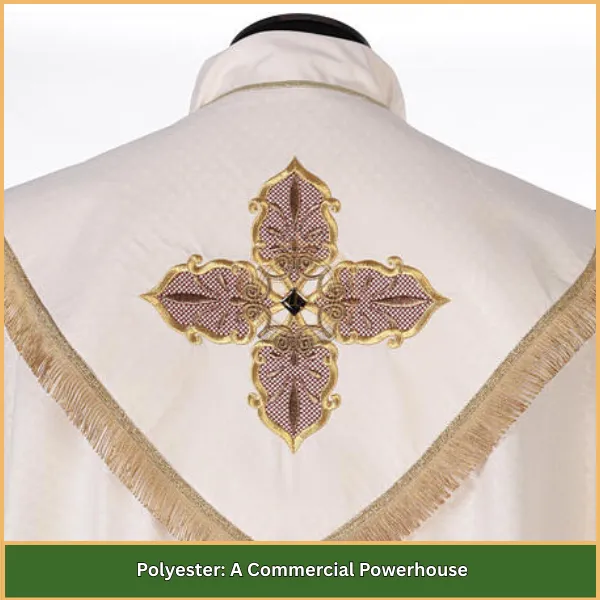
It is a synthetic fiber that has become a go-to fabric in commercial embroidery.
It’s commonly found in athletic wear, uniformes, enfriar, and promotional apparel. Polyester is lightweight, fuerte, no destiñe, and resistant to shrinking and wrinkles.
Admite diseños de densidad ligera a media y funciona mejor con estabilizadores como malla invisible o desgarrable.. Sin embargo, tiene una textura resbaladiza, por lo que es importante colocar un aro o flotar con cuidado.
Dado que es sensible al calor, siempre debes probar tus ajustes de planchado.
Las mezclas de poliéster son especialmente populares debido a su durabilidad y capacidad de resistir lavados frecuentes.. Los precios generalmente oscilan entre $3 a $10 per yard, dependiendo de la calidad.
Beneficios:
- No se encoge ni se arruga
- Ideal para producción a granel y durabilidad.
Desventajas:
- Puede moverse en el aro
- Sensible al calor y requiere planchado a baja temperatura.
Many production shops agree it’;es el La mejor tela para bordar. al hacer un trabajo repetido.
6. Lino: Para una apariencia natural y texturizada

It is a natural fiber made from flax that’s loved for its vintage appeal and breathable texture.
It’s slightly looser in weave than cotton but can hold embroidery stitches well if properly stabilized.
Linen is perfect for monograms, heirloom stitching, and elegant home décor like tea towels, runners, and wall art.
It tends to fray more easily, so edge finishing is recommended.
Always use a strong stabilizer and consider starching the fabric before stitching to improve handling.
Pre-washing is also important to reduce shrinkage. Linen typically costs $10 a $25 per yard, depending on thread count and blend.
Beneficios:
- Natural, aspecto texturizado
- Comfortable and classic
Desventajas:
- Loosely woven and frays easily
- Requires proper stabilization
Looking for charm and tradition? This could be what fabric is best for embroidery with a heritage feel.
7. Mezclilla: Tough and On-Trend
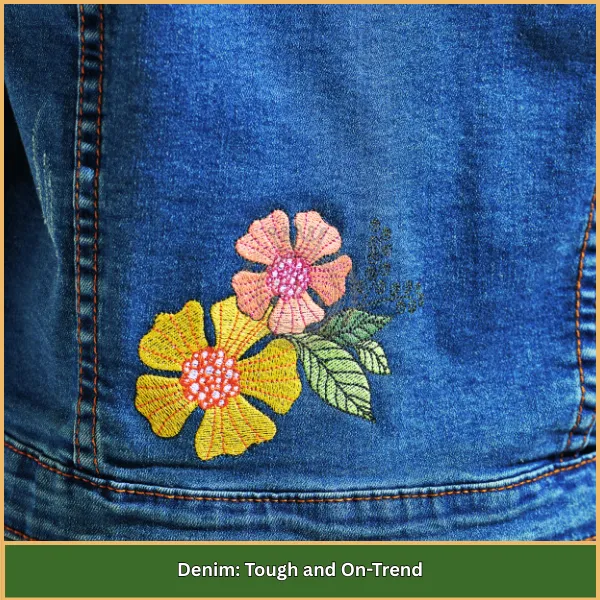
It is a heavyweight cotton twill fabric that brings both durability and style to embroidery.
It’s commonly used for jackets, vaqueros, bolsas de tela, delantales, y accesorios.
Denim’s tight weave supports heavy stitch designs, making it ideal for bold graphics and patches.
Because of its thickness, it requires a sturdy needle (90/14 o mas alto) and a strong cut-away stabilizer.
Hooping denim can be difficult, so some users prefer floating it.
You may need to reduce machine speed for better results. Denim stands up to frequent washing and wear. Pricing typically ranges from $7 a $18 per yard, depending on weight and quality.
Beneficios:
- Great for dense stitching and durability
- Stylish and long-lasting
Desventajas:
- Challenging to hoop
- Requires slower stitch speeds and stronger needles
It often stands out as a robust choice for que tela usar para bordar when working on apparel or gear.
Errores comunes al elegir qué tela usar para bordar
Muchos principiantes cometen los mismos errores al seleccionar la tela., Lo que puede afectar la calidad del bordado.. Aquí están los más comunes.:
- Elegir tela elástica sin estabilizador: Las telas elásticas como el jersey o el spandex pueden distorsionar los diseños si no se combinan con un estabilizador recortable..
- Saltarse el prelavado: Las telas como el algodón y el lino se encogen después del lavado.. Si no está prelavado, tu diseño puede arrugarse después del primer lavado.
- Usar técnicas de encuadre incorrectas: Tirar la tela demasiado apretada o floja en el aro provoca costuras desiguales o quemaduras en el aro.
- No hacer coincidir la aguja con la tela: Usar el tipo o tamaño de aguja incorrecto puede dejar agujeros, romper hilos, o dañar la tela.
Diseño demasiado denso para la tela.: Las costuras pesadas en telas livianas pueden provocar arrugas y desgarros.. Siempre haga coincidir la densidad del diseño con la resistencia de la tela.
Consejos para solucionar problemas sobre qué tela utilizar para bordar
Sigues teniendo problemas después de seleccionar tu tela? Aquí hay soluciones probadas:
- Frunce después de coser: Esto suele deberse a aros flojos o estabilizadores débiles.. Utilice un estabilizador recortable y asegúrese de que la tela esté bien ajustada al tambor..
- Tela deslizándose en el aro: Común con telas resbaladizas como la seda o el poliéster.. Envuelva el aro interior con cinta de sarga o haga flotar la tela con cinta de bordar..
- El diseño no se alinea correctamente: Causado por tela inestable o velocidad de puntada demasiado rápida. Utilice un estabilizador firme y reduzca la velocidad..
- Agujeros de aguja en la tela: Esto sucede en telas delicadas cuando se usa una aguja gruesa o sin filo.. Utilice un afilado, aguja de menor tamaño y reducir la densidad de puntada.
- La tela elástica provoca diseños ondulados: Utilice siempre un estabilizador recortado y evite estirar la tela durante el bastidor..
Comparación rápida de la mejor tela para bordar a máquina
Tela | Texture &; Sentir | Nivel de durabilidad | Facilidad de colocar el aro | Proyectos ideales | Punta estabilizadora |
Algodón | Suave y transpirable | Moderado | muy facil | Pañales, camisetas, bloques de colcha | Arrancar o recortar |
Lienzo | Firme y estructurado | muy alto | Desafiante (flotar) | Bolsas de mano, decoración del hogar, pancartas | corte |
Sintió | Suave y denso | Bajo a moderado | muy facil | parches, aplique, pequeñas manualidades | Opcional o desmontable |
Seda | Suave con brillo natural | Bajo | muy dificil | Accesorios nupciales, arte enmarcado | Malla invisible o lavable. |
Poliéster | Resbaladizo y elástico | Alto | Moderado | Uniformes, ropa de deporte, ropa comercial | Malla invisible o desgarrable. |
Lino | Grueso y transpirable | Moderado | Moderado | monogramas, decoración de reliquia familiar | corte |
Mezclilla | Grueso y resistente | muy alto | Duro | Chaquetas, vaqueros, mochilas | corte |
Veredicto final
Ya, has visto esa elección que tela usar para bordar afecta cada parte de su diseño final, Del aro a la durabilidad.. Seleccione según sus necesidades de diseño, prueba tu configuración, y prepara tu tela de forma inteligente.
Recuerda, ya sea un proyecto de hobby o una pieza profesional, La digitalización EM puede hacer que su diseño adaptar perfectamente. Ofrecemos digitalización personalizada optimizada para su tipo de tejido con calidad garantizada., 24/7 apoyo, y un 50% descuento en tu primer pedido.
Asi que PEDIR AHORA y experimentate a ti mismo!
preguntas frecuentes
Un tejido de peso medio, entre 150–250 G/M, es mejor para bordar. No es ni muy grueso ni muy fino. Mantiene bien los puntos y es fácil pasar la aguja.. Esto lo hace bueno tanto para bordado a mano como a máquina..
Los tres tipos principales son:
- Tejidos (como el algodón y el lino) – Lo mejor para la estabilidad y la facilidad de costura
- Telas no tejidas (como fieltro) – Ideal para hacer parches
- Tejidos de punto (como camiseta) – Puede funcionar bien con un estabilizador y cuidado.
Las telas tejidas son la opción más fácil y común..
Sí, Puedes bordar en casi cualquier tejido siempre que una aguja pueda atravesarlo.. Pero es mejor empezar con telas no elásticas como algodón, lino, o lienzo. Es más fácil trabajar con estos, especialmente para principiantes.
La tela detrás de la tela principal se llama estabilizador o respaldo de bordado. Soporta las puntadas y evita que su diseño se mueva o se arrugue.. Usar respaldo desprendible para tejidos resistentes y respaldo recortado para los elásticos o delgados
Elige un peso medio, tela densamente tejida hecho de materiales naturales como algodón o lino. también, Piense en cómo se utilizará el artículo. Elija duradero., tela que no encoge si se lavará o usará con frecuencia. Una buena tela ayuda a que su diseño dure más y se vea mejor.
